2307
Poor England
Daily Mail has posted photos (type, published for the first time) bytovuhi poor in England 40 years ago. That is, in the 70 years of the 20th century. The period of "golden age" in the Soviet Union, by the way. Won it as. Interestingly, by the way, not even so much the pictures as captions ...
via
Poverty: Mrs M huddles with her four young children in sotsdome that they shared with her husband in Balsall Heath, Birmingham. Their house has no bathroom, hot water and interior walls oozing moisture. The kids slept on wet lattices matrsov, prostelennyh pair of old coats. They are depicted in January 1969, when a thick layer of snow lying on the streets and windows were broken.
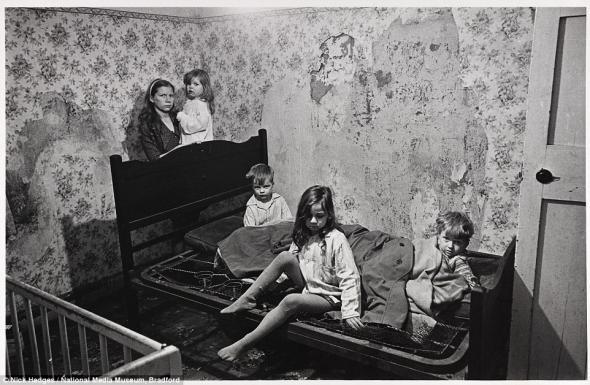
Despair: Mrs. X had lived with her husband and son in an apartment block in Glasgow, which was abandoned by all other families. One morning the couple woke up to find that brignada demolition began to tear down their house. In the photo, Ms. X company brings their child through piles of construction debris in the cold, unlit house.

Deprived: Mrs. T and her family of five, including her child depicted in this photograph in May 1969, and lived in a dorm razvalyuvayuschimsya owned steel mill in Sheffield. They did not have no gas, no electricity, no hot water, no bathroom. Mrs T was forced to cook on the fire in the living room.

Tightness: Three generations of Irish families pictured in November 1969, lived together in the same room of the basement in a communal apartment house in Toxteth in Liverpool. Members of the nine families posing under his underwear, which is dried by the heat of the drying chamber at a makeshift rope.

Hunger: a woman and her child looking out of the kitchen in the slums of municipal apartments in Balsall Heath, Birmingham in November 1969. Above them, the rope for drying clothes, tied to an open tube vodoprovada in damp room.
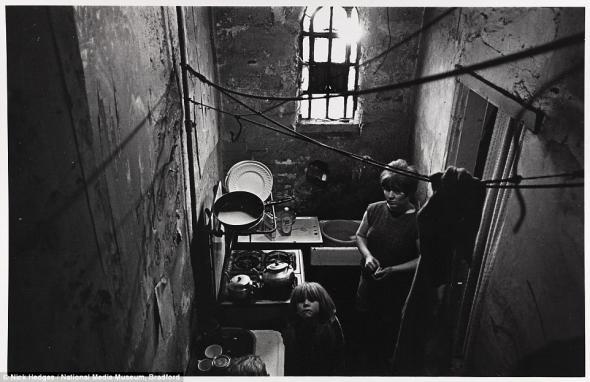
Striving for normality: Peering into the shard of mirror on the wall, a young woman apply makeup in a basement in Glasgow, where she lives, in October 1970. Next to her, slowly dripping from a faucet in the sink dirty. Light pours through the broken window, hastily closed cardboard from discarded cereal boxes.

Overcrowding: Mr. and Mrs. Gallagher lived with her four children on the ground floor of an apartment flat in Maryhill, Glasgow. Their bedroom in puddles of rain water, and at night they sleep with the light on to keep the rats away - one night they counted 16 rats in the room. In the photo, Mr. Gallagher with one of their children in January 1970.
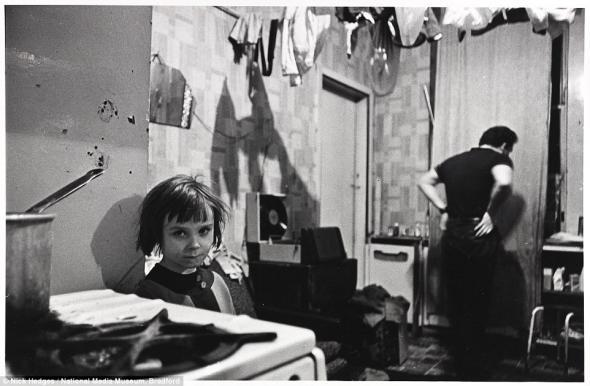
Nerves: A young girl tries to calm a crying baby, holding his chest. Couple standing in front of a wall with peeling wallpaper in the place which the photographer describes as & quot; accommodation below the standard & quot; in Balsall Heath, Birmingham in June 1969

Mr. Hedges photographed slums in major cities such as Glasgow, Birmingham, Manchester, Leeds, Bradford and London, documenting the daily struggle for survival in the harsh conditions of poverty and the country faced more than three million people.
While the focus on domestic issues was very unusual for a documentary photographer, war and international stories were preferred in the world of media.
Despite that the photos were taken decades ago, pictures have not been shown publicly since the law obliges to "protect the anonymity of the subjects" for 40 years. He has presented his 1000 photo in the National Museum of the media in 1983, but they could not be published for that reason.
During the project, Mr. Hedges came across families who slept with the light to scare away the rats scurrying around their house at night; bedrooms, covered with puddles of rainwater and kitchen walls are decorated with layers of peeling wallpaper.
Slums: moldy and cracked plaster adorning the walls, and laundry drying on the cooker, the boy standing alone in the kitchen slum houses in Birmingham, Duddleston, in August 1970

Horror: Mrs. Chichockjy and her daughter, pictured in July 1971. The then Minister of Housing, Peter Walker, visited their house in Liverpool. When the picture was taken, Mrs. Chichockjy photographer said that Mr. Walker admitted that it was "not fit for human habitation conditions»,
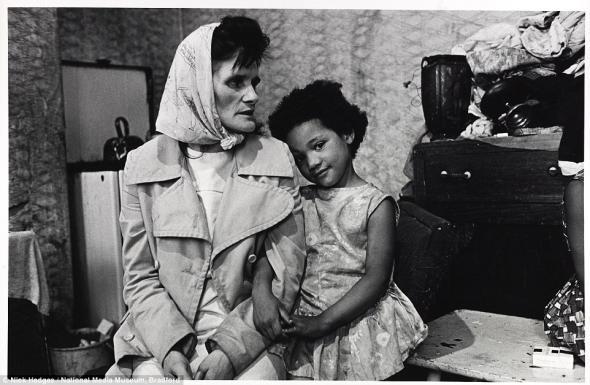
Lunch time: Ms. T crouches before the hearth in the house where she lives with her husband, Mr. T (pictured), Toxteth, Liverpool.

Discouragement: Young girl standing in front of a number of townhouses in Moss Side, Manchester. In the 1960s and early 1970s, Manchester City Council demolished many of the houses of the Victorian era and Edwardian west of Moss Side and replace them with new apartment buildings.
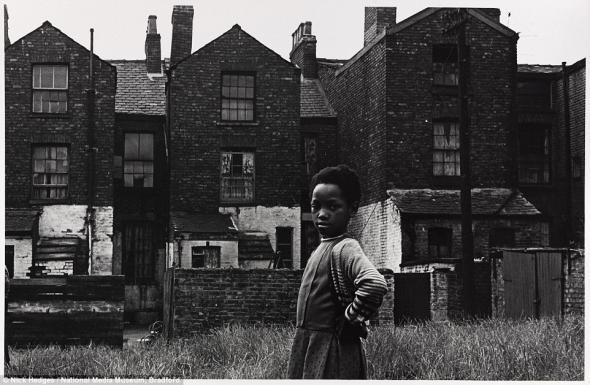
Imagination: These children are photographed in Glasgow in 1970, played with homemade wedding fatami outside. At that time it was very unusual for a documentary photographer to focus on domestic issues, while war and international scenes prevailed in the media.
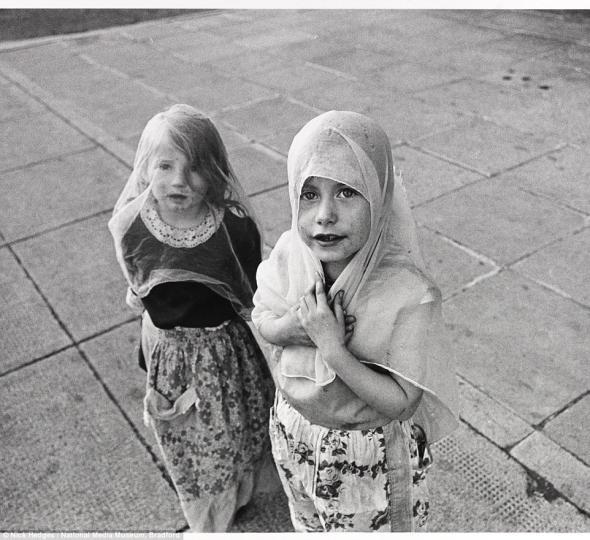
Desolation: apartment buildings are in the area for demolition in Salford, Manchester, in June 1971. Photos have not been published for 40 years at the request of law protecting the anonymity of the subjects

Just another day in dirty clothes girl poses for a photo in the East End of London in 1969, among the piles of garbage and raskvashennyh newspapers that surround the basement, where she lived.

Ghosts: Girl looks out of the window in the door in a communal apartment in a house in Toxteth, Liverpool in March 1969.
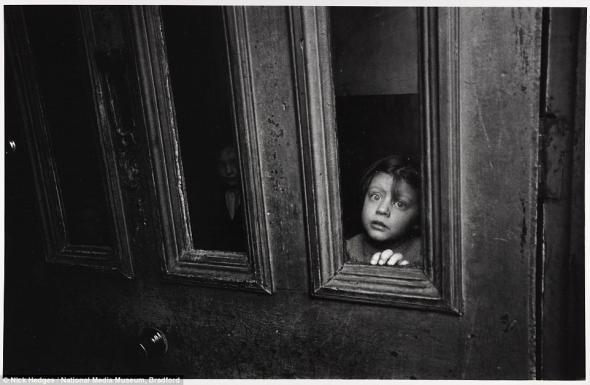
Anarchy: Nick Hedges photographed face boy living in poverty, which stands in a deserted street in Toxteth, Liverpool in 1969, with mud smeared across his face.

Wasteland: the man with his hands in his pockets, away from dull terraced houses in Leeds in July 1970, followed by a woman walks her dog beside her pram.

Ominously: Three boys playing with guns along the cobbled streets between rows of closely standing houses in Leeds in July 1970. The End.

via
Poverty: Mrs M huddles with her four young children in sotsdome that they shared with her husband in Balsall Heath, Birmingham. Their house has no bathroom, hot water and interior walls oozing moisture. The kids slept on wet lattices matrsov, prostelennyh pair of old coats. They are depicted in January 1969, when a thick layer of snow lying on the streets and windows were broken.

Despair: Mrs. X had lived with her husband and son in an apartment block in Glasgow, which was abandoned by all other families. One morning the couple woke up to find that brignada demolition began to tear down their house. In the photo, Ms. X company brings their child through piles of construction debris in the cold, unlit house.

Deprived: Mrs. T and her family of five, including her child depicted in this photograph in May 1969, and lived in a dorm razvalyuvayuschimsya owned steel mill in Sheffield. They did not have no gas, no electricity, no hot water, no bathroom. Mrs T was forced to cook on the fire in the living room.

Tightness: Three generations of Irish families pictured in November 1969, lived together in the same room of the basement in a communal apartment house in Toxteth in Liverpool. Members of the nine families posing under his underwear, which is dried by the heat of the drying chamber at a makeshift rope.

Hunger: a woman and her child looking out of the kitchen in the slums of municipal apartments in Balsall Heath, Birmingham in November 1969. Above them, the rope for drying clothes, tied to an open tube vodoprovada in damp room.

Striving for normality: Peering into the shard of mirror on the wall, a young woman apply makeup in a basement in Glasgow, where she lives, in October 1970. Next to her, slowly dripping from a faucet in the sink dirty. Light pours through the broken window, hastily closed cardboard from discarded cereal boxes.

Overcrowding: Mr. and Mrs. Gallagher lived with her four children on the ground floor of an apartment flat in Maryhill, Glasgow. Their bedroom in puddles of rain water, and at night they sleep with the light on to keep the rats away - one night they counted 16 rats in the room. In the photo, Mr. Gallagher with one of their children in January 1970.

Nerves: A young girl tries to calm a crying baby, holding his chest. Couple standing in front of a wall with peeling wallpaper in the place which the photographer describes as & quot; accommodation below the standard & quot; in Balsall Heath, Birmingham in June 1969

Mr. Hedges photographed slums in major cities such as Glasgow, Birmingham, Manchester, Leeds, Bradford and London, documenting the daily struggle for survival in the harsh conditions of poverty and the country faced more than three million people.
While the focus on domestic issues was very unusual for a documentary photographer, war and international stories were preferred in the world of media.
Despite that the photos were taken decades ago, pictures have not been shown publicly since the law obliges to "protect the anonymity of the subjects" for 40 years. He has presented his 1000 photo in the National Museum of the media in 1983, but they could not be published for that reason.
During the project, Mr. Hedges came across families who slept with the light to scare away the rats scurrying around their house at night; bedrooms, covered with puddles of rainwater and kitchen walls are decorated with layers of peeling wallpaper.
Slums: moldy and cracked plaster adorning the walls, and laundry drying on the cooker, the boy standing alone in the kitchen slum houses in Birmingham, Duddleston, in August 1970

Horror: Mrs. Chichockjy and her daughter, pictured in July 1971. The then Minister of Housing, Peter Walker, visited their house in Liverpool. When the picture was taken, Mrs. Chichockjy photographer said that Mr. Walker admitted that it was "not fit for human habitation conditions»,

Lunch time: Ms. T crouches before the hearth in the house where she lives with her husband, Mr. T (pictured), Toxteth, Liverpool.

Discouragement: Young girl standing in front of a number of townhouses in Moss Side, Manchester. In the 1960s and early 1970s, Manchester City Council demolished many of the houses of the Victorian era and Edwardian west of Moss Side and replace them with new apartment buildings.

Imagination: These children are photographed in Glasgow in 1970, played with homemade wedding fatami outside. At that time it was very unusual for a documentary photographer to focus on domestic issues, while war and international scenes prevailed in the media.

Desolation: apartment buildings are in the area for demolition in Salford, Manchester, in June 1971. Photos have not been published for 40 years at the request of law protecting the anonymity of the subjects

Just another day in dirty clothes girl poses for a photo in the East End of London in 1969, among the piles of garbage and raskvashennyh newspapers that surround the basement, where she lived.

Ghosts: Girl looks out of the window in the door in a communal apartment in a house in Toxteth, Liverpool in March 1969.

Anarchy: Nick Hedges photographed face boy living in poverty, which stands in a deserted street in Toxteth, Liverpool in 1969, with mud smeared across his face.

Wasteland: the man with his hands in his pockets, away from dull terraced houses in Leeds in July 1970, followed by a woman walks her dog beside her pram.

Ominously: Three boys playing with guns along the cobbled streets between rows of closely standing houses in Leeds in July 1970. The End.

























